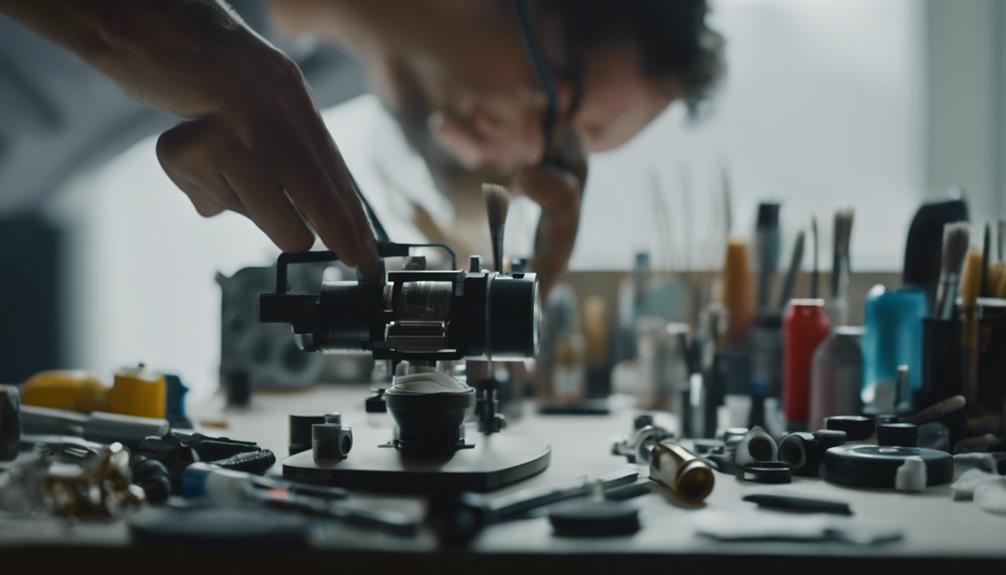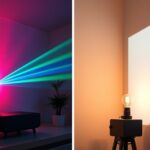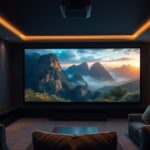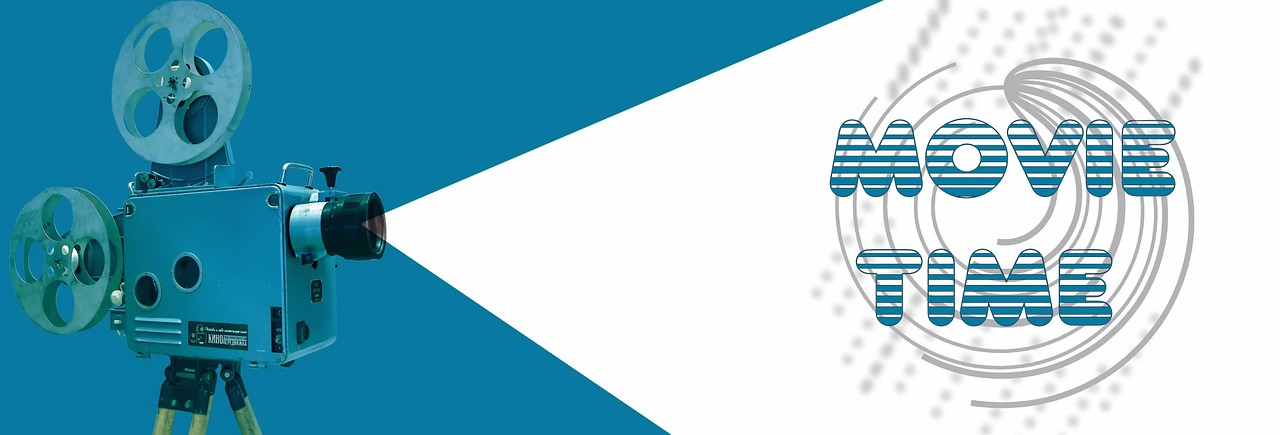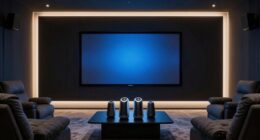You've likely seen how projector technology has evolved from clunky CRT systems to the modern laser projectors dominating today's market. CRT projectors were known for their excellent image quality but struggled with size and portability. As digital projection emerged in the late 1990s, it offered superior clarity in more manageable designs. This led to the rise of LCD and DLP technologies, ensuring vibrant visuals and enhanced user experiences. Now, laser projectors deliver exceptional brightness and longevity, with features catering to both home and professional use. If you're curious about what's next in projections, there's much more to discover.
Key Takeaways
- CRT projectors dominated the market in the late 20th century but faced limitations in size and portability, leading to a decline.
- The late 1990s marked the rise of digital projectors, offering improved image quality and compact designs suitable for various applications.
- DLP and LCD technologies emerged, enhancing color accuracy and contrast, with projectors evolving to meet professional and home entertainment needs.
- Laser projectors, introduced in the mid-2010s, provided exceptional brightness, longer lifespans, and instant functionality, revolutionizing projection technology.
Historical Overview of Projection Technology

The evolution of projection technology, which began with the Camera Obscura in the 4th century BC, has shaped the way we experience visual storytelling today. This early device demonstrated the principles of light projection and image inversion, setting the groundwork for future advancements.
Fast forward to 1659, when Christiaan Huygens introduced the Magic Lantern, utilizing hand-painted glass plates to create engaging presentations that captivated audiences.
As you explore deeper into the history of projection, consider Eadweard Muybridge's zoopraxiscope from 1879, which combined still images to project motion, ultimately laying the foundation for modern cinema.
The late 20th century marked a significant shift with the introduction of CRT projectors, which dominated the market for years. However, as technology progressed, the change to digital projection began in the late 1990s, providing clearer images and greater reliability.
This historical overview highlights how projection technology has evolved from simple light-based devices to more sophisticated systems, paving the way for today's digital projection landscape. Each step in this journey reflects a quest for better visual experiences, leading us to the advanced technologies we enjoy today.
Transition From CRT to Digital

As you explore the shift from CRT to digital projectors, you'll notice the limitations that led to CRT's decline.
The rise of digital projection brought advancements in image quality and portability that CRT simply couldn't match.
Additionally, the integration of high-quality sound systems into home theater setups has enhanced the overall viewing experience, allowing for immersive audio-visual presentations.
This change not only transformed the market but also changed how you experience visual content, making it essential to evaluate components like sound system configuration for peak performance.
CRT Limitations and Decline
CRT projectors, despite their impressive performance, faced significant limitations that led to their decline in favor of more compact digital alternatives.
Introduced in the mid-20th century, CRT projectors delivered exceptional black levels and high resolutions. However, their bulky and heavy designs, like the iconic Sony VPH-G90 weighing in at 110 kg, made installation and mobility challenging.
As digital technologies emerged, particularly with the launch of LCD projectors in the late 1980s, users began to prefer lighter, more user-friendly options. These digital alternatives not only simplified setup but also provided adequate brightness and resolution for both professional and home use.
By the late 1990s, the market saw a significant shift as demand for CRT projectors waned, marking the beginning of their decline.
While CRT systems accounted for a large portion of the market until then, the advantages of digital projectors were hard to ignore. As a result, the shift from CRT to digital technologies became inevitable, paving the way for a new era in projection solutions.
The decline of CRT technology highlighted the industry's need for innovation and adaptability in a rapidly changing landscape.
Rise of Digital Projection
Digital projection technology surged in popularity during the late 1990s, providing users with compact, user-friendly alternatives that outperformed bulky CRT projectors.
As you explored this new world of digital projectors, you'd notice several key advantages:
- Size and Weight: Unlike the heavy CRT systems, digital projectors like the LCD projector were lighter and easier to transport, making them perfect for both business and home use.
- Image Quality: DLP technology, introduced by Texas Instruments, offered superior image quality and color accuracy, which became a game-changer for movie enthusiasts and professionals alike.
- Versatility: Digital projectors quickly became the standard, with LCD and DLP models dominating the market. They catered to various applications, from presentations to home theaters.
Advancements in Image Quality
The shift from CRT to digital projection marked a considerable leap in image quality, enabling brighter, sharper visuals that captivated audiences in both home theaters and professional settings.
Early digital projectors, like LCDs, improved color brightness but were soon overshadowed by DLP technology, which utilized a digital micromirror device (DMD) to enhance image quality. DLP projectors offered high contrast ratios and superior color accuracy, making them a popular choice for home cinema enthusiasts.
As digital technology advanced, laser projectors emerged in the mid-2010s, revolutionizing the industry once again. These projectors provided exceptional brightness levels, often exceeding 3,000 lumens, and boasted lifespans of over 20,000 hours, minimizing maintenance concerns. Their wide color gamuts allowed for more vibrant and lifelike images, elevating the viewing experience considerably.
Today, the introduction of 4K and even 8K resolution projectors has taken image clarity to new heights, catering to your desire for high-definition visuals. With each technological stride, whether through DLP or laser projectors, you can enjoy an unparalleled viewing experience that continues to push the boundaries of what's possible in image quality.
Rise of LCD and DLP

In the late 20th century, LCD and DLP technologies emerged as game-changers in projection, offering users compact designs and impressive image quality. The introduction of these technologies marked a significant change from traditional CRT systems, making projectors more accessible for various settings.
- The first LCD projector, launched by Epson in 1989, utilized three small LCD panels, enhancing the evolution towards user-friendly projection technology.
- DLP technology, introduced by Texas Instruments in 1987, gained traction with its digital micromirror devices, which improved contrast and color accuracy.
- By the mid-2000s, both LCD and DLP projectors became standard choices, with DLP leading advancements into 4K resolution.
Early LCD projectors, while limited to a resolution of 1024×768, quickly evolved, finding their place in both professional and home environments.
DLP technology, showcased by the Infocus X1, demonstrated compact size and reliable performance.
As you explore the rise of these technologies, you'll appreciate how they've shaped modern projection, providing a stunning visual experience that continues to redefine standards in the industry.
Innovations in Laser Projection

When you explore innovations in laser projection, you'll notice key advantages that set it apart from traditional options.
Enhanced image quality and brightness levels make for a superior viewing experience, whether you're watching movies or giving presentations.
As you look ahead, future trends in projection technology promise even more exciting developments on the horizon.
Key Advantages of Laser
Laser projectors stand out for their impressive brightness and contrast, making them ideal for any lighting situation. Whether you're presenting in a brightly lit room or showcasing a movie at home, these projectors deliver exceptional performance.
Here are three key advantages of laser technology:
- Longer Lifespan: With laser light sources, you're looking at over 20,000 hours of use. That's considerably longer than traditional lamp-based projectors, which means fewer maintenance and replacement costs for you.
- Instant Usability: Forget the annoying warm-up and cool-down times. Laser projectors can be turned on and off instantly, allowing you to start your presentations or movie nights without delay.
- Versatile Installation: Many laser projectors come with ultra-short throw capabilities. This feature lets you project large images in tight spaces, giving you more flexibility in how you set up your space.
These advantages contribute to exceptional brightness levels and enhanced image quality, making laser projectors a top choice for both home and professional environments.
Embrace the future of projection technology with laser!
Enhanced Image Quality
Enhanced image quality in laser projection comes from innovations that boost brightness, color accuracy, and overall performance, ensuring stunning visuals for any setting. With laser projectors, you can expect higher brightness levels, often exceeding 10,000 lumens, which makes them perfect for various lighting conditions. The RGB laser light sources enhance the color gamut, delivering vivid and true-to-life colors that previous technologies couldn't achieve.
Here's a quick comparison of key features of laser projectors:
| Feature | Description | Benefit |
|---|---|---|
| Brightness | Over 10,000 lumens | Clear images in bright rooms |
| Color Gamut | Wider range due to RGB sources | More accurate, vivid colors |
| Lifespan | Over 20,000 hours | Reduced maintenance costs |
| 4K Enhancement | High contrast ratios | Sharper, clearer images |
| Instant On/Off | No warm-up or cool-down time | Immediate usability |
With these advancements, laser projectors not only provide enhanced image quality but also elevate your viewing experience by combining performance and convenience.
Future Trends in Projection
As laser projectors continue to evolve, innovations are setting the stage for even more impressive advancements in projection technology. You'll enjoy a more immersive home entertainment experience thanks to these trends:
- Extended Lifespan: With laser projectors exceeding 20,000 hours of operation, you can say goodbye to frequent maintenance and replacement costs associated with traditional lamp systems.
- Enhanced Color and Brightness: The introduction of RGB laser light sources considerably boosts color accuracy and brightness. This means you'll see vibrant images, even in various ambient light conditions, making your viewing experience more enjoyable.
- Ultra-Short Throw Capabilities: Innovations, like the AWOL Vision LTV-3500pro, enable large screen sizes in compact spaces. You can transform any room into a theater without the need for extensive setup.
Additionally, using special CLR screens with your laser projectors can reject up to 90% of ambient light, ensuring you achieve UHD image quality even in bright environments.
As these technologies continue to advance, it's clear that laser projectors are becoming an indispensable choice for modern home entertainment.
Features of Modern Projectors

Modern projectors consistently deliver exceptional brightness levels, often exceeding 3000 lumens, which guarantees vibrant images even in well-lit rooms. This impressive brightness is particularly beneficial for presentations and movie nights, ensuring you won't miss details due to ambient light.
One of the standout features of modern projectors is their use of laser light sources. These projectors not only offer longer lifespans—over 20,000 hours—but they also reduce maintenance and replacement costs, making them a smart investment.
Additionally, the enhanced color gamut in these devices provides more accurate and vivid colors, often supporting HDR (High Dynamic Range) for a richer viewing experience. You'll appreciate how this technology brings images to life, showcasing every shade and tone more effectively than older models.
Moreover, with ultra-short throw capabilities, modern projectors can create large screen sizes (up to 120 inches) from just a few inches away from the projection surface. This makes them ideal for smaller spaces without compromising your viewing experience.
Lastly, many of these projectors come with built-in smart technology, allowing seamless integration with streaming services and smart home systems, adding convenience to your viewing habits.
Impact on Home Entertainment

Laser projectors are revolutionizing home entertainment by offering stunning picture quality and flexibility, making it easier for you to enjoy cinematic experiences in the comfort of your living room. With advancements in technology, these projectors bring a new level of immersion to your home cinema setup.
Here are three key benefits of laser projectors:
- Larger Screen Sizes: Laser projectors provide impressive screen sizes that can transform any room into a mini-theater, allowing you to experience movies as they were meant to be seen.
- Higher Brightness Levels: With their ability to perform well in well-lit environments, laser projectors guarantee that you won't miss any detail, even during daytime screenings.
- Extended Lifespan: Offering over 20,000 hours of use, laser projectors greatly reduce maintenance costs compared to traditional lamp-based projectors, making them a smart investment for your home.
The integration of smart technology further enhances your experience, allowing seamless streaming and control.
As laser projectors continue to gain popularity, they're set to dominate the market, bringing high-definition and 4K options right into your living space.
Future Trends in Projection Technology

The future of projection technology promises exciting advancements, including the rise of 3D systems and augmented reality integration that will elevate your viewing and presentation experiences. Imagine being immersed in vivid 3D projection systems that bring your favorite films and presentations to life. This realistic visual experience will transform how you engage with content.
As you look ahead, you'll also notice a shift towards eco-friendly projection solutions. These energy-efficient options not only reduce your carbon footprint but also cater to the growing demand for sustainable technology in homes and offices.
Portable projectors are set to become more compact and versatile, making it easy for you to take your presentations on the go. With cloud-based content management systems, controlling and updating your projection content will be seamless and hassle-free.
Here's a quick look at some key future trends:
| Trend | Impact |
|---|---|
| 3D Projection Systems | Enhanced visual engagement |
| Eco-friendly Solutions | Sustainable usage |
| Portable Projectors | Convenient and versatile use |
| Cloud Management Systems | Simplified content control |
These advancements will redefine your projection experiences in the years to come!
Frequently Asked Questions
What Is the Evolution of the Projector?
You'll find projectors evolved considerably over time, starting with CRT models for high resolution. Then, LCD and DLP emerged, leading to today's advanced laser projectors, enhancing brightness, lifespan, and overall viewing experiences.
What Is the History of CRT Projectors?
You'll find that CRT projectors emerged in the mid-20th century, excelling in image quality but suffering from bulkiness and maintenance issues. By the late 1990s, they faced decline due to more efficient digital technologies.
What Is the Laser Technology in Projectors?
When it comes to laser projectors, you'll find they're a game changer. They use laser light for brighter images, richer colors, and longer lifespans, making your viewing experience both vivid and hassle-free.
What Is the History of Computer Projector?
The history of computer projectors started with bulky CRT models, then advanced to compact LCDs in 1989. DLP technology improved image quality, leading to digital projectors and, eventually, efficient laser projectors with superior brightness and color.
Conclusion
So, here we are, living in a world where projectors have evolved from flickering CRT dinosaurs to sleek laser wizards capable of turning your living room into a mini IMAX.
You can now binge-watch your favorite shows on a screen that's practically bigger than your house!
Who needs the cinema when you've got a laser projector that makes your popcorn taste like gourmet?
Buckle up, because the future of projection tech is soaring, and it's brighter than your neighbor's 4K obsession!

